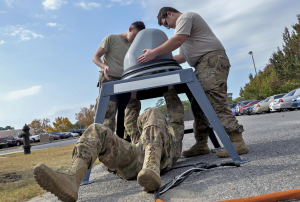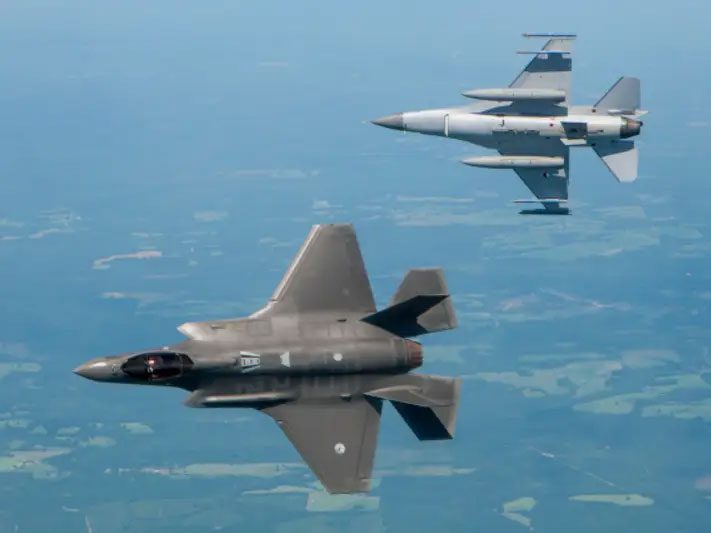The National Football League, the US Air Force, Human Performance, and Talent Management

Just ponder for a minute—I mean take off the “we can’t do that hat”… just for a minute—Treating military members like athletes involves adopting a comprehensive approach to physical training, mental conditioning, injury prevention, and overall wellness, similar to how professional athletes in the NFL are managed. Just spitballing here, but here are several strategies the USAF could employ using the NFL as an analogue:

Comprehensive Training Programs:
- Physical Fitness: Implement position-specific physical training programs that cater to the unique demands of different roles within the USAF, much like how NFL players follow tailored routines to enhance performance in their specific positions.
- Skills Development: Introduce specialized training to improve job-specific skills, akin to how NFL players practice drills that are relevant to their roles on the field.
Health and Wellness Support:
- Nutritional Guidance: Provide access to nutritionists (most MDGs have these already) who can create personalized meal plans to optimize performance and recovery, similar to the dietary support NFL players receive.
- Mental Health Services: Offer robust mental health and sports psychology resources to help airmen cope with stress, enhance mental resilience, and improve focus—paralleling the mental conditioning resources available to professional athletes (I do know we have a shortage).
Injury Prevention and Recovery:
- Medical and Rehab Facilities: Invest in state-of-the-art medical and rehabilitation facilities to provide the best care for injuries and expedite recovery, mirroring the medical support infrastructure available to NFL teams. This saves money for the VA in the long run.
- Preventative Measures: Implement programs focused on injury prevention, including proper warm-up routines, strength training, and flexibility exercises, akin to protocols in professional sports.
Rest and Recovery:
- Scheduled Rest: Ensure that service members have adequate rest and recovery periods integrated into their training schedules to prevent overtraining and fatigue, similar to off-seasons and bye weeks in the NFL.
- Recovery Techniques: Adopt advanced recovery techniques such as cryotherapy, massage, and hydrotherapy that are commonly used by athletes to maintain peak physical condition.

Performance Analytics:
- Data-Driven Training: Utilize wearable technology and analytics to monitor performance, physical condition, and risk factors, allowing for data-driven adjustments to training and recovery plans, similar to the analytics used in professional sports to optimize athlete performance.
- Feedback Systems: Develop systems for continuous feedback and performance evaluations, helping airmen to understand their progress and areas for improvement, akin to the film study and performance reviews in professional sports.
Professional Development and Leadership:
- Career Longevity: Focus on long-term career development and skill diversification to ensure service members have fulfilling, sustainable careers in the USAF, much like the player development and post-career transition programs in the NFL.
- Team Cohesion and Leadership: Foster a strong sense of team unity and develop leadership skills among service members, reflecting the emphasis on teamwork and leadership within professional sports teams.

By adopting these strategies—which does not seem like a stretch, the USAF can enhance the physical and mental well-being of its service members, improve operational effectiveness, and contribute to the long-term health and career sustainability of its personnel, akin to how professional athletes are developed and managed in the NFL.
WELLNESS AND HP
The USAF has attempted the comprehensive airman fitness (CAF) program for many years, before that we had HAWC (health and wellness centers), it seem that the one size fits all approach does not work. Ponder human performance (HP) through the lens of wellness encompassing a holistic approach integrating physical, mental, emotional, and social health to optimize an airman’s overall functioning and capabilities. In this context, wellness is not merely the absence of illness or infirmity but a dynamic process of becoming aware of and making choices toward a more successful existence. This approach significantly enhance human performance by ensuring airmen are not only physically prepared but also mentally resilient, emotionally balanced, and socially supported.
Here’s how these dimensions contribute to human performance:
- Physical Wellness: Involves regular physical activity, proper nutrition, and adequate rest, which are essential for maintaining strength, flexibility, endurance, and overall physical health. Physical wellness contributes to human performance by enhancing energy levels, reducing the risk of chronic diseases, and improving the body’s ability to handle stress and recover from exertion.
- Mental and Emotional Wellness: Pertains to the ability to process thoughts and feelings in a healthy way. It includes stress management, emotional regulation, resilience, and a positive outlook. Mental and emotional wellness is crucial for focus, decision-making, problem-solving, and coping with the challenges and pressures that can affect performance.
- Social Wellness: Involves building healthy, supportive relationships and engaging with a community. Social support systems can provide encouragement, reduce stress, and contribute to a sense of belonging and purpose. Effective communication, empathy, and interpersonal skills are components of social wellness that can enhance teamwork and collaboration, critical aspects of performance in many settings.
- Intellectual Wellness: Involves engaging in creative and mentally stimulating activities to keep the mind sharp and expand knowledge and skills. Lifelong learning, openness to new ideas, and intellectual curiosity can enhance problem-solving abilities and adaptability, contributing to improved performance.
- Spiritual Wellness: For some, this may include specific religious beliefs or practices, while for others, it might involve a sense of purpose, direction, or connection to something greater than oneself. Spiritual wellness can contribute to resilience, ethical decision-making, and a sense of peace or contentment.
- Occupational and Environmental Wellness: Relates to finding fulfillment in one’s job and working in a safe, supportive, and healthy environment. Satisfaction and motivation in one’s work can significantly affect performance, as can the physical and psychological safety of the workplace.

When these dimensions of wellness are addressed and integrated into an individual’s lifestyle and support systems, human performance can be significantly enhanced. This holistic approach ensures individuals are not only capable of performing their tasks effectively but are also resilient in the face of challenges, adaptable to change, and capable of sustained high performance over time.
THE COMBINE
Back to the NFL and The Combine. The NFL Combine is an annual event that serves as a showcase where college football players perform physical and mental tests in front of National Football League (NFL) coaches, general managers, and scouts. This event typically occurs in late February or early March, ahead of the NFL Draft in April, and is held at Lucas Oil Stadium in Indianapolis, Indiana.
The Combine consists of a series of standardized tests and drills designed to evaluate the physical skills, mental acuity, and psychological resilience of the participants. Key components include:
- 40-yard dash: This test measures straight-line speed over a short distance, which is crucial for many positions in football.
- Bench press: Athletes perform as many repetitions as possible of 225 pounds (102 kg) to test upper body strength.
- Vertical jump: This measures lower-body power and explosiveness by assessing how high an athlete can jump from a standstill.
- Broad jump: Also known as the standing long jump, this tests an athlete’s lower-body strength and explosiveness over distance.
- 3-cone drill: This assesses an athlete’s ability to change directions at high speed, which is essential for positions that require agility.
- Shuttle run: Also known as the 20-yard shuttle, this test measures speed, agility, and change-of-direction ability.
- Position-specific drills: Athletes perform drills that highlight the skills and movements relevant to their specific positions on the field.
- Interviews: Teams conduct interviews with players to assess their character, intelligence, and football acumen.
- Psychological testing: Players may undergo various psychological tests designed to assess their mental toughness, critical thinking, and ability to handle stress and adversity.
- Medical evaluations: Comprehensive physical examinations are conducted to assess the health and injury history of the athletes.
The NFL Combine is a crucial event in the pre-draft process, providing teams with vital information that helps them make informed decisions in the NFL Draft. It is also an opportunity for athletes to improve their draft stock by showcasing their physical and mental abilities to NFL teams. For the USAF—a combine type event might serve as a baseline from which commanders/directors might gain information on where their airmen perform well and where they strangle. The Air Force might not see all events, but a sampling might serve as an interesting beta test.

TALENT
The NFL’s approach to talent scouting, team building, and performance optimization is a multifaceted process that involves a combination of analytics, traditional scouting, strategic planning, and player development. Each team in the league has its own specific methodologies and priorities, but there are several common strategies and practices across the league.
Talent Scouting:
- College Scouting: NFL teams have scouts dedicated to analyzing college football talent across the country. These scouts attend college games, watch game tape, evaluate player performances at the NFL Combine, and conduct interviews to assess both the physical abilities and the intangible qualities of prospects.
- Pro Scouting: Teams also scout players who are already in the NFL or other professional leagues, including practice squads and international leagues, to identify potential additions through free agency, trades, or waiver claims.
- Advanced Analytics: Many teams have embraced advanced statistics and analytics to evaluate player performance and potential. Metrics such as player efficiency ratings, win shares, and other advanced stats are used alongside traditional scouting to make informed decisions.
Team Building:
- NFL Draft: The draft is a critical component of team building, allowing teams to select college players to fill roster needs. Teams often build their core through the draft, emphasizing the importance of effective scouting and talent evaluation.
- Free Agency: Teams can acquire veteran talent through free agency to address immediate needs, add depth, or bring in leadership. Balancing the salary cap is crucial, as teams must manage their resources to build a competitive roster without jeopardizing future financial flexibility.
- Player Development: Developing young talent is key to sustained success. Teams invest in coaching, training facilities, and support services to help young players reach their potential.
- Culture and Chemistry: Successful teams also focus on building a positive team culture and strong locker room chemistry. Leadership from veterans and the coaching staff plays a significant role in fostering an environment where players can thrive.
Performance Optimization:

- Strength and Conditioning: NFL teams have comprehensive strength and conditioning programs designed to maximize player athleticism and minimize injuries. These programs are tailored to individual player needs and positions.
- Nutrition and Recovery: Teams employ nutritionists and recovery specialists to ensure players are fueling their bodies correctly and effectively managing recovery, including sleep, rehabilitation, and mental health.
- Sports Science: The use of sports science technologies, such as GPS tracking in practice, biometric monitoring, and advanced injury prevention techniques, has become increasingly prevalent in optimizing player performance and health.
- Coaching and Scheme Adaptation: Coaches play a crucial role in performance optimization by developing game plans that leverage player strengths and minimize weaknesses. Continuous learning, adaptation, and innovation in schemes and strategies are vital for staying competitive.
The NFL’s approach to talent scouting, team building, and performance optimization is a holistic and ongoing process that requires collaboration across multiple departments within each organization. Teams that excel in these areas tend to have sustained success on the field, demonstrating the importance of a strategic and well-rounded approach to managing an NFL roster.
SIX FIGHTS
The United States Air Force (USAF) has identified six key fights that articulate its strategic approach to applying airpower in defense of allies, partners, and national interests. These fights encompass a broad spectrum of military operations, ranging from competition and deterrence in peacetime to conflict and sustainment during warfare. Understanding these fights helps to grasp the multifaceted role of airpower in contemporary security challenges.

The Fight to Compete with or Deter:
- This fight focuses on peacetime and crisis operations designed to compete strategically against adversaries and deter them from aggressive actions. It involves a mix of presence, posture, and engagement activities aimed at demonstrating resolve, capability, and readiness to defend interests and uphold international norms. Activities might include strategic bomber task force deployments, freedom of navigation operations, and joint exercises with allies and partners.
The Fight to Get into Theater:
- This fight emphasizes the ability to project forces into a theater of operations rapidly and efficiently. It involves overcoming challenges such as long distances, geopolitical constraints, and potential adversary attempts to deny access and mobility (Anti-Access/Area Denial, A2/AD). Key elements include air mobility (strategic airlift and air refueling), basing rights negotiations, and pre-positioning of materiel.
The Fight to Get Airborne:
- Once in theater, the challenge shifts to launching air operations effectively. This fight involves ensuring the readiness and survivability of air assets in the face of threats such as enemy air defenses and cyber attacks. It includes the rapid generation of combat sorties, protection of air bases, and the employment of agile and resilient command and control systems.
The Fight for Air Superiority:
- Air superiority—control of the airspace—is fundamental to all subsequent military operations. This fight involves defeating adversary air forces and neutralizing air defenses to secure a favorable air situation. It encompasses air-to-air combat, suppression/destruction of enemy air defenses (SEAD/DEAD), and electronic warfare.
The Fight to Deny Adversary Objectives:
- This fight is about preventing adversaries from achieving their strategic and operational goals. It can involve direct attacks on enemy forces and infrastructure, information operations to disrupt command and control, and support to ground and naval forces to halt enemy advances. The focus is on employing precision, speed, and flexibility to disrupt enemy plans and initiatives.
The Fight to Sustain Ourselves, Our Allies, and Partners:
- Sustaining operations over prolonged periods, especially in contested environments, is a critical challenge. This fight encompasses logistics, maintenance, personnel recovery, and medical support to ensure continuous operations. It also includes coalition support, ensuring allies and partners have the necessary capabilities, interoperability, and integration to contribute effectively to joint and combined efforts.

These six fights collectively represent the USAF’s strategic framework for employing airpower across the spectrum of competition, conflict, and war. They highlight the dynamic and complex nature of modern air operations, requiring adaptability, innovation, and close cooperation with joint and multinational partners to achieve strategic objectives and protect national and allied interests.

SIX FIGHTS AND THE NFL
Applying the NFL’s method of training, recruiting, scouting, and talent management to the USAF’s six key fights could potentially revolutionize the way the Air Force prepares for and engages in modern warfare. The NFL’s approach, characterized by meticulous talent scouting, rigorous training regimens, strategic team building, and continuous performance optimization, offers a comprehensive model for developing and maintaining a high-performance team. Translating these methods into a military context, particularly within the framework of the six fights, could yield significant benefits:
- Enhanced Readiness and Deterrence: Like scouting for top NFL talent, identifying and recruiting individuals with unique skills and high potential could strengthen the USAF’s capabilities in cyber warfare, space operations, and other specialized areas. Tailored training and development programs would ensure that personnel are not only technically proficient but also tactically astute, enhancing the USAF’s readiness and ability to deter adversaries effectively.
- Optimized Force Projection: The NFL’s focus on physical conditioning and injury prevention could be mirrored in the preparation of USAF personnel for the rigors of deployment. Just as NFL teams use data analytics to optimize performance and reduce downtime, the USAF could employ advanced analytics to manage the health and readiness of its forces, ensuring they are fit and prepared for rapid global deployment.
- Agile and Resilient Operations: The strategic team-building aspect of the NFL, where each player’s role is clearly defined yet adaptable, mirrors the need for versatility and resilience in the Air Task Force concept. By fostering a culture of cross-training and flexibility, the USAF can create agile units capable of responding to dynamic threats and operating effectively under a broad spectrum of conditions.
- Dominance in the Battlespace: Just as the NFL emphasizes specialized training and tactics for different positions and game situations, the USAF can enhance its dominance in air superiority and multi-domain operations through specialized, scenario-based training. This would prepare personnel to execute complex strategies and utilize cutting-edge technologies effectively against adversaries.
- Strategic Denial of Adversary Goals: In the NFL, in-depth analysis of opponents’ strategies and tendencies is crucial for game planning and execution. Similarly, the USAF could leverage intelligence and reconnaissance to understand and anticipate adversary movements and intentions better, allowing for preemptive actions and strategic countermeasures that disrupt and deny adversary objectives.
- Sustained Engagement and Support: The NFL’s emphasis on team cohesion and morale, along with its comprehensive support systems for players, highlights the importance of sustaining the human element in high-stress environments. By prioritizing the welfare, resilience, and continuous development of its personnel, the USAF can maintain high levels of morale and effectiveness, ensuring sustained engagement and support for allies and partners.
In conclusion, integrating the NFL’s methodologies into the USAF’s approach to the six fights could significantly enhance strategic capabilities, operational effectiveness, and overall readiness. By adopting best practices in talent management, training, and team building from one of the most competitive sports leagues in the world, the USAF could set a new standard for military excellence and innovation, ensuring it remains well-equipped to address the challenges of modern warfare and protect national and allied interests in an increasingly complex global security environment.



0 Comments